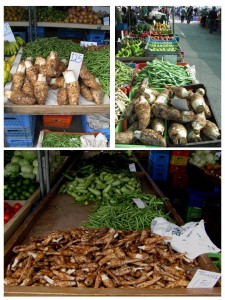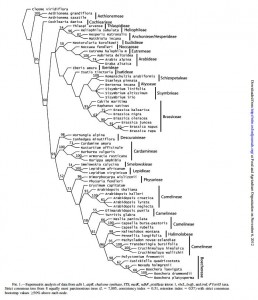- The genesis of irrigated terraces in al-Andalus. A geoarchaeological perspective on intensive agriculture in semi-arid environments (Ricote, Murcia, Spain). They were built very early on, on a specific soil type, by first burning the vegetation and then essentially inverting the soil profile.
- Creating patches of native flowers facilitates crop pollination in large agricultural fields: mango as a case study. Sweet.
- The ecology of plant populations: their dynamics, interactions and evolution. A whole special issue. Most intriguing is perhaps review of plant-pollinator interactions on the Galapagos. All very important for in situ conservation of crop wild relatives.
- Diversity in global maize germplasm: Characterization and utilization. Three priorities: phenotyping, phenotyping, phenotyping.
- Phytotracker, an information management system for easy recording and tracking of plants, seeds and plasmids. They could have used GRIN-Global, but I guess that doesn’t track plasmids.
- Increasing influence of heat stress on French maize yields from the 1960s to the 2030s. Any day with maximum temperature above 32°C is bad, and their recent increase has led to yield stagnation. They are going to increase further, which means that the French are going to have to find a 12% increase in base yields by 2035 or eat less maize. Do they in fact eat any maize now? What countries are now like what France will be like in 2035?
- Combined impact of multiple exotic herbivores on different life stages of an endangered plant endemism, Medicago citrina. IUCN says it’s endangered. Rabbits, mice and rats are important parts of the problem.
- Estimating species richness: still a long way off!. Bummer.
- New allelic variants found in key rice salt-tolerance genes: an association study. A couple possibly interesting mutations identified by EcoTILLING bunch of IRRI accessions. We shall see if anything comes of them. Actually, how will we find out if something does? I hope the info will go back into the IRRI genebank documentation system.
Brainfood: Sierra Leone rice, Bean breeding, Cacao geographic diversity, Red fleshed apples, Species richness & productivity, African maize diversity, Human expansion, Barley gaps, Wild coffee and CC, Acacia and CC, Genetic erosion
- Analysis of genetic diversity in farmers’ rice varieties in Sierra Leone using morphological and AFLP markers. Still a lot of diversity in traditional rice after the war, both among and within landraces, mostly among, organized regionally, and recognized by local names.
- Simultaneous selection for resistance to five bacterial, fungal, and viral diseases in three Andean × Middle American inter-gene pool common bean populations. Thanks goodness for multiple independent domestication events. And genebanks.
- Present Spatial Diversity Patterns of Theobroma cacao L. in the Neotropics Reflect Genetic Differentiation in Pleistocene Refugia Followed by Human-Influenced Dispersal. So need to collect in areas at the margins or just outside the refugia if you want high diversity. But of course that may already be ex situ. But wait, didn’t you just do the analysis based on the provenance of ex situ holdings?
- An ancient duplication of apple MYB transcription factors is responsible for novel red fruit-flesh phenotypes. The whole genome got duplicated during evolution of the apple and the red flesh phenotype is controlled by loci in both copies, but in different ways.
- What is the form of the productivity–animal-species-richness relationship? A critical review and meta-analysis. Positive.
- Spatial Structure and Climatic Adaptation in African Maize Revealed by Surveying SNP Diversity in Relation to Global Breeding and Landrace Panels. Distinct Sahelian, Western and Eastern clusters. Some SNPs associated with high temperatures.
- MtDNA analysis of global populations support that major population expansions began before Neolithic Time. Humans needed good weather to thrive, not agriculture.
- Genetic gap analysis of wild Hordeum taxa. Argentina?
- The Impact of Climate Change on Indigenous Arabica Coffee (Coffea arabica): Predicting Future Trends and Identifying Priorities. Generally very bad to disastrous, but some “core localities” will be ok, and therefore could be used for in situ conservation. Interestingly, genebank accession locality data not used.
- The genus Acacia (Fabaceae) in East Africa: distribution, diversity and the protected area network. No such luck for Acacia, I’m afraid.
- Monocropping Cultures into Ruin: The Loss of Food Varieties and Cultural Diversity. Are you sure you want to know what a sociologist and a political scientist have to say on the matter?
Taro in the Levant
 I was reminded during a recent trip back to Cyprus (my first visit in 20 years after living there for quite a while) of the curious fact that taro is a staple of traditional Cypriot cuisine, something of an outlier in the Mediterranean. Called kolokassi, the tuber is prepared in a number of ways, and the young offshoots, or suckers, are also taken fried. You can see these in the photo, labelled “poulles.”. Peter J. Matthews has this to say in his “Genetic Diversity in Taro, and the Preservation of Culinary Knowledge“:
I was reminded during a recent trip back to Cyprus (my first visit in 20 years after living there for quite a while) of the curious fact that taro is a staple of traditional Cypriot cuisine, something of an outlier in the Mediterranean. Called kolokassi, the tuber is prepared in a number of ways, and the young offshoots, or suckers, are also taken fried. You can see these in the photo, labelled “poulles.”. Peter J. Matthews has this to say in his “Genetic Diversity in Taro, and the Preservation of Culinary Knowledge“:
In Cyprus only one cultivar of taro is grown, but there are at least nine distinct ways of preparing taro (skhara, vrasto, souppa skourdalia, tiganites, kappamas, yiakhni, psito, moussakas, Matthews 1998a) (Figure 4). The fermentation of taro starch, and the edibility of leaves (petioles and blades) are not known in Cyprus. All the methods recorded use heat to reduce acridity — by simmering, boiling, stewing, frying, roasting, grilling, and baking (steaming was not reported). For each named dish, the details of preparation varied from person to person and village to village. The range of dishes is not large, compared to the range in Japan (Matthews 1995), but does involve a greater range of methods for applying heat.
You can find out more in the book “The Global Diversity of Taro: Ethnobotany and Conservation,” in which Dr Matthews has also had a hand. Poulles are not mentioned, which makes me think their consumption may be a relatively recent innovation.
It’s not clear where that one Cypriot cultivar may have come from, though Matthews says that the crop “is likely to have reached Cyprus in ancient times from India or Africa, via the Levant or Egypt.” That makes sense, but will be difficult to verify, as there is precious little in the way of germplasm collections in the region between Europe and India. I would imagine Egypt in particular would be fertile territory for a bit of collecting. I wasn’t able to find any ancient Egyptians representations of the plant, but I wouldn’t be surprised if they exist.
Nibbles: Biodiversity economics, ICARDA social network, Beyond food miles, Heirlooms on BBC, Cannabis, Research funding, Cacao diversity, Agriculture from the air, Sustainable intensification example, Research whine, Japanese botanic garden visit, European PGR network, Tribal Glycene, Youth in agriculture
- Oxford Review of Economic Policy has special volume on biodiversity economics. Not much ag, though, settle down.
- ICARDA announces on Twitter the existence of a new Facebook page which looks a bit like the old one.
- It’s the fertilizer miles, stupid.
- Great British Food Revival does heirloom carrots. Oh and beer.
- Good news for a particular agricultural biodiversity subsector from Amsterdam and Colorado. The Dude unavailable for comment. For obvious reasons.
- If you’re from Ghana, Nigeria, South Africa, Tanzania and Uganda and are doing research on Neglected and Underutilized Species you’ll be interested in this call or research proposals from ISF.
- Bioversity deconstructs that paper on the spatial analysis of Theobroma diversity. I still don’t quite get why they didn’t do the gap analysis.
- Farming from the air. And more along the same lines. Or polygons, I suppose I should say. Can you estimate diversity from the air? I bet you can.
- Sustainable intensification in (sort of) action.
- Damn rice farmers not playing ball.
- Oxford botany geeks visit Japan, identify wood of bench in noodle bar.
- 13th meeting ECPGR Steering Committee. All the documents you’ll need. And then some.
- Soybean as a vegetable. Possibly an acquired taste.
- How to keep young people on the farm? “Perhaps the first point to recognise is that the evidence base on which to build policy and programmes is frighteningly thin.”
The relationships among food plants
…I wasn’t able to find out if Wasabia and Armoracia are much related, though I doubt it.
 No doubt I gave up too easily, something else I probably wouldn’t do now, like alliterate post titles and neglect to search for ex situ holdings. Anyway, the paper Toward a Global Phylogeny of the Brassicaceae 1, which came out a few months before that 2006 blog post on mine on wasabi which I have been revisiting, clearly relegates Eutrema (aka Wasabia) and Armoracia to quite distinct clades of the Brassicaceae (click on the phylogenetic diagram to see for yourself). Thanks to Ruaraidh for tracking that down. Not least because it gives me a chance to also link to yesterday’s post at The Botanist in the Kitchen on the phylogenetic tree of food plants in general, and nevermind that it doesn’t seem to feature wasabi.
No doubt I gave up too easily, something else I probably wouldn’t do now, like alliterate post titles and neglect to search for ex situ holdings. Anyway, the paper Toward a Global Phylogeny of the Brassicaceae 1, which came out a few months before that 2006 blog post on mine on wasabi which I have been revisiting, clearly relegates Eutrema (aka Wasabia) and Armoracia to quite distinct clades of the Brassicaceae (click on the phylogenetic diagram to see for yourself). Thanks to Ruaraidh for tracking that down. Not least because it gives me a chance to also link to yesterday’s post at The Botanist in the Kitchen on the phylogenetic tree of food plants in general, and nevermind that it doesn’t seem to feature wasabi.